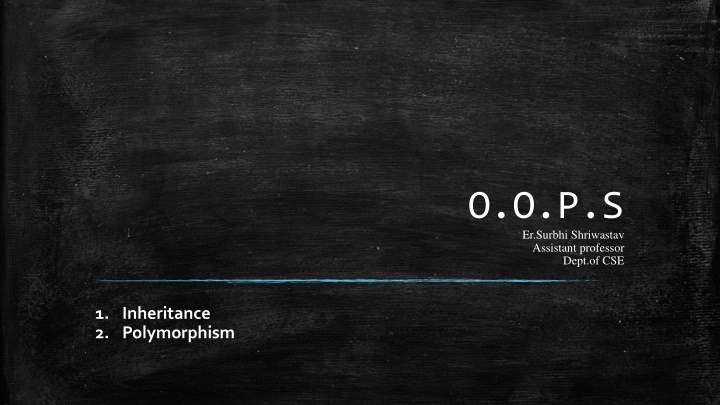
Object-Oriented Programming Principles and Inheritance
Dive into the world of Object-Oriented Programming (OOP) with a focus on Inheritance. Discover the importance of OOP in software design, learn about different types of inheritance, and grasp the concept of building class hierarchies. Explore how OOP can enhance the development process for complex systems.
Download Presentation

Please find below an Image/Link to download the presentation.
The content on the website is provided AS IS for your information and personal use only. It may not be sold, licensed, or shared on other websites without obtaining consent from the author. If you encounter any issues during the download, it is possible that the publisher has removed the file from their server.
You are allowed to download the files provided on this website for personal or commercial use, subject to the condition that they are used lawfully. All files are the property of their respective owners.
The content on the website is provided AS IS for your information and personal use only. It may not be sold, licensed, or shared on other websites without obtaining consent from the author.
E N D
Presentation Transcript
O.O.P.S Er.Surbhi Shriwastav Assistant professor Dept.of CSE 1. Inheritance 2. Polymorphism
What is O.O.P.S.? : Object-oriented programming (OOP) is a computer programming model that organizes software design around data, or objects, rather than functions and logic. An object can be defined as a data field that has unique attributes and behavior. OOP focuses on the objects that developers want to manipulate rather than the logic required to manipulate them. This approach to programming is well-suited for programs that are large, complex and actively updated or maintained. This includes programs for manufacturing and design, as well as mobile applications; for example, OOP can be used for manufacturing system simulation software.
Inheritance : In object-oriented programming, inheritance is the mechanism of basing an object or class upon another object (prototype-based inheritance) or class (class-based inheritance), retaining similar implementation. Also defined as deriving new classes (sub classes) from existing ones such as super class or base class and then forming them into a hierarchy of classes. In most class-based object-oriented languages, an object created through inheritance, a "child object", acquires all the properties and behaviors of the "parent object" , with the exception of: constructors, destructor, overloaded operators and friend functions of the base class. Add your second bullet point here
Types of Inheritance: Single inheritance : where subclasses inherit the features of one superclass. A class acquires the properties of another class. Multiple inheritance : where one class can have more than one superclass and inherit features from all parent classes.
Types of Inheritance(continued) : Multilevel inheritance : where a subclass is inherited from another subclass. It is not uncommon that a class is derived from another derived class as shown in the figure "Multilevel inheritance". The classA serves as abase classfor thederived classB, which in turn serves as a base classfor thederived classC. The classB is known asintermediatebase class because it provides a link for the inheritance between A andC. The chainABCis known asinheritance path.
Types of Inheritance(continued) : Hybrid Inheritance : Hybrid inheritance is when a mix of two or more of the above types of inheritance occurs. An example of this is when class A has a subclass B which has two subclasses, C and D. This is a mixture of both multilevel inheritance and hierarchal inheritance. Hierarchical Inheritance : This is where one class serves as a superclass (base class) for more than one sub class. For example, a parent class, A, can have two subclasses B and C. Both B and C's parent class is A, but B and C are two separate subclasses.
Polymorphism: In programming language theory and type theory, polymorphism is the provision of a single interface to entities of different types or the use of a single symbol to represent multiple different types. The concept is borrowed from a principle in biology where an organism or species can have many different forms or stages. Polymorphism means "many forms", and it occurs when we have many classes that are related to each other by inheritance. Like we specified in the previous chapter; Inheritance lets us inherit attributes and methods from another class. Polymorphism uses those methods to perform different tasks
Static Polymorphism : It is also known as Compile-time polymorphism. This type of polymorphism is achieved by Method overloading or Operator overloading. Method Overloading: When there are multiple functions with the same name but different parameters then these functions are said to be overloaded. Functions can be overloaded by change in the number of arguments or/and a change in the type of arguments.
Static Polymorphism(continued): Operator Overloading: Operator overloading is a compile-time polymorphism. It is an idea of giving special meaning to an existing operator in C++ without changing its original meaning. Example: int a; float b,sum; sum=a+b; Here, variables a and b are of types int and float , which are built-in data types. Hence the addition operator + can easily add the contents of a and b . This is because the addition operator + is predefined to add variables of built-in data type only.
Dynamic Polymorphism : It is also known as Dynamic Method Dispatch. It is a process in which a function call to the overridden method is resolved at Runtime. This type of polymorphism is achieved by Method Overriding. Method overriding, on the other hand, occurs when a derived class has a definition for one of the member functions of the base class. That base function is said to be overridden.






















